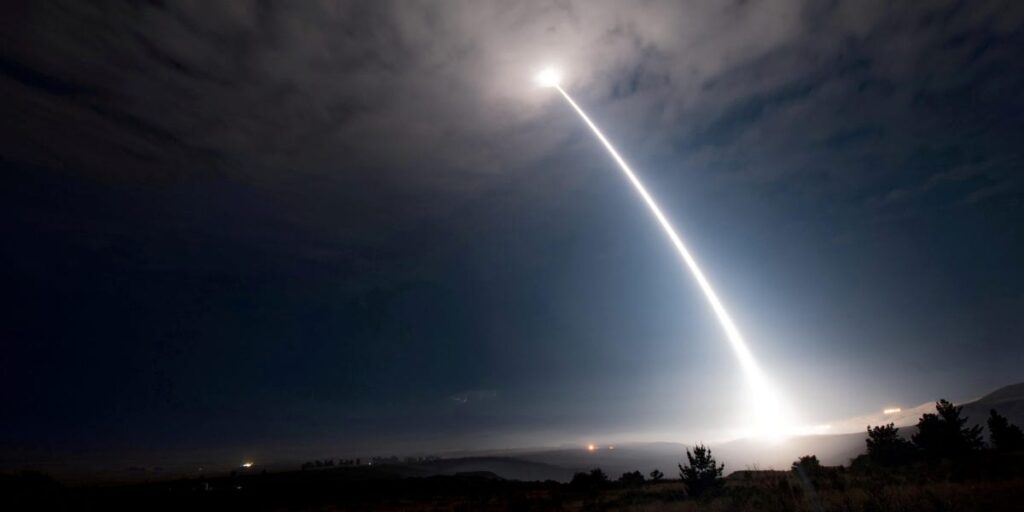The Air Force has stood ready to defend the US with its nuclear-armed Minuteman III intercontinental ballistic missiles for over 50 years. Now the service might be forced to extend that into the 2050s, a new report said.
Officials plan to replace the aging Minuteman III with the new Sentinel ICBM, but severe cost overruns and delays have curtailed that nuclear missile program and left the Pentagon struggling to figure out solutions.
According to the US Government Accountability Office, a watchdog agency that reports to Congress, the Air Force believes it must continue to maintain Minuteman III missiles over the next decade and beyond while Sentinel is completed. Sentinel, manufactured by Northrop Grumman, was originally planned to replace all 450 Minuteman III missiles beginning later this decade at an estimated cost of $78 billion.
In the years since the Sentinel contract was awarded in 2020, both the delivery timeline and cost have ballooned. The US Department of Defense estimates the Sentinel will now cost over $140 billion and be delayed by years, with deployment potentially expected sometime in the 2030s.
The Pentagon has blamed this on an unrealistic delivery schedule, problems with Sentinel’s engineering and system design, an atrophied ICBM industrial base, and organizational issues within the Air Force, GAO said. ICBMs are the land-based element of the US’ nuclear triad, which also includes submarine-launched ballistic missiles and nuclear bombs carried by aircraft like the B-2 bomber.
The Sentinel is a three-stage solid-fuel missile that will purportedly have a lighter carbon composite structure and more advanced electronics and systems for easier upgrades. It’s also expected to be able to carry more warheads than its predecessor.
The Air Force has said transitioning from Minuteman III to Sentinel is a complex project involving not only converting old silos to new ones capable of hosting Sentinel but also keeping Minuteman III forces in a ready status while Sentinel is introduced.
In July, Lt. Gen. Andrew Gebara, the Air Force’s deputy chief of staff for strategic deterrence and nuclear integration, said at a Mitchell Institute for Aerospace Studies think tank event that cost growth was largely attributed to infrastructure work to build “all the launch facilities, all the launch centers, all the wiring, all that goes into that.”
But larger critical missteps in the Air Force’s management of Sentinel and the transition to the new ICBM have been documented for years. Earlier this year, the Federation of American Scientists think tank wrote that the Air Force “assumed that the Sentinel would be able to reuse much of the original Minuteman launch infrastructure,” including refurbishment of 450 missile silos. Now, it appears the service will have to build new launch facilities, including new silos — hardened underground launchers spread across the central US where the missiles are maintained and kept in a high state of readiness.
In the meantime, the Air Force will continue to operate and maintain its Minuteman III system as a nuclear deterrent, with the timeline to retire them still being figured out by the service.
But keeping Minuteman III missiles online will be challenging. Per the report, many parts for the ICBM are either limited in supply or obsolete, and the Air Force doesn’t have a plan for continued Minuteman III test flights. Minuteman III program officials told the GAO it’s possible to keep the missile running until 2050, but it’ll require overhauls of some subsystems that add to the government’s higher costs.
While the Air Force is confident the ICBM can be used through the next decades, they told the GAO there are unknowns in ground electrical subsystems and electronics that could degrade the missiles. Previously, officials had said keeping Minuteman III running wasn’t feasible because of how it expensive it would be and risks to sustaining the missiles.
Despite issues, the Air Force is continuing work on the Sentinel and acknowledging the need to restructure the program. “Work can still continue under the contract that exists today, so we don’t want to slow down, come to a full stop on the program,” Gebara said earlier this year. “But there definitely needs to be a restructure to get after the cost growth that’s happened.”
Read the full article here


